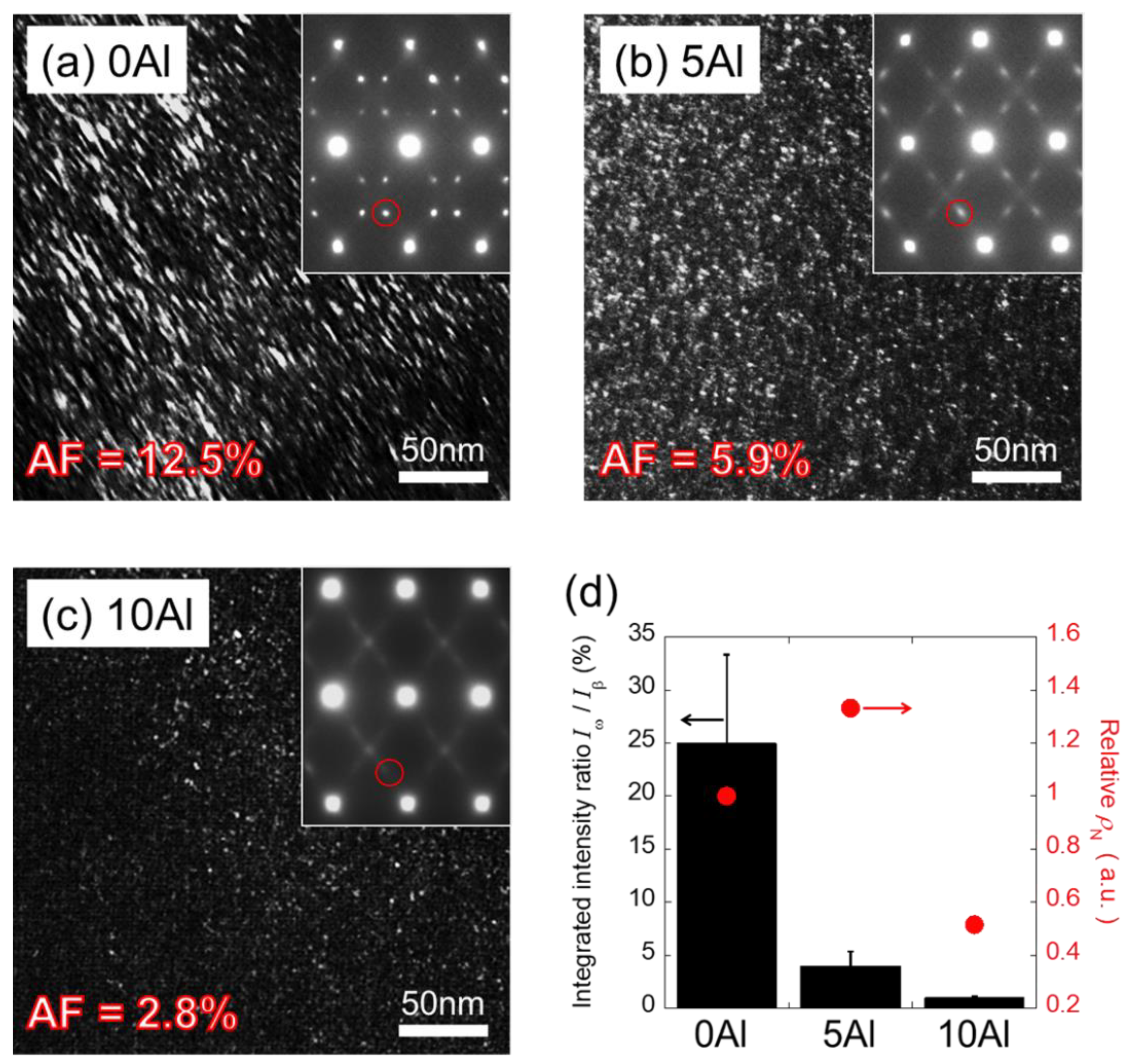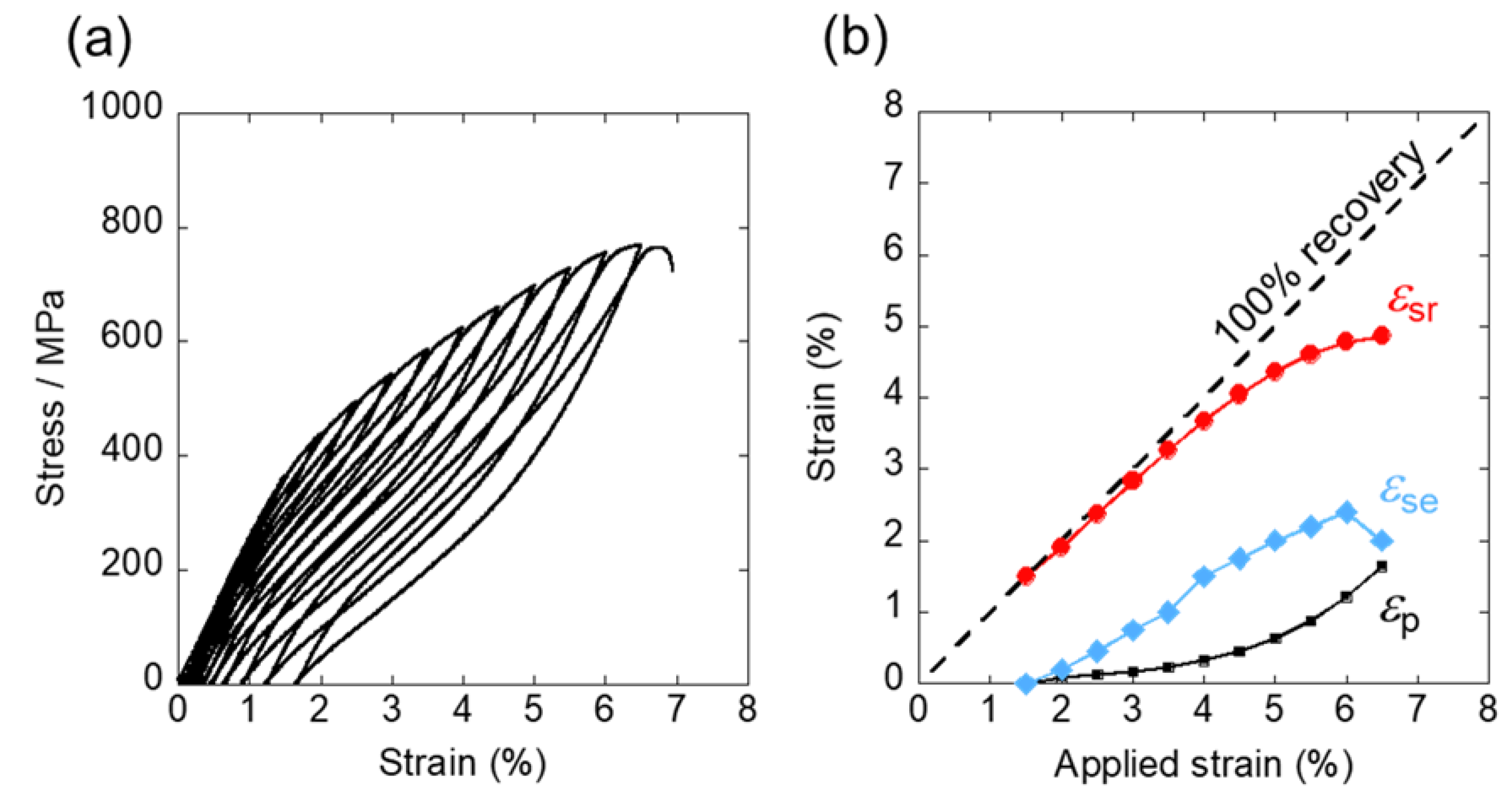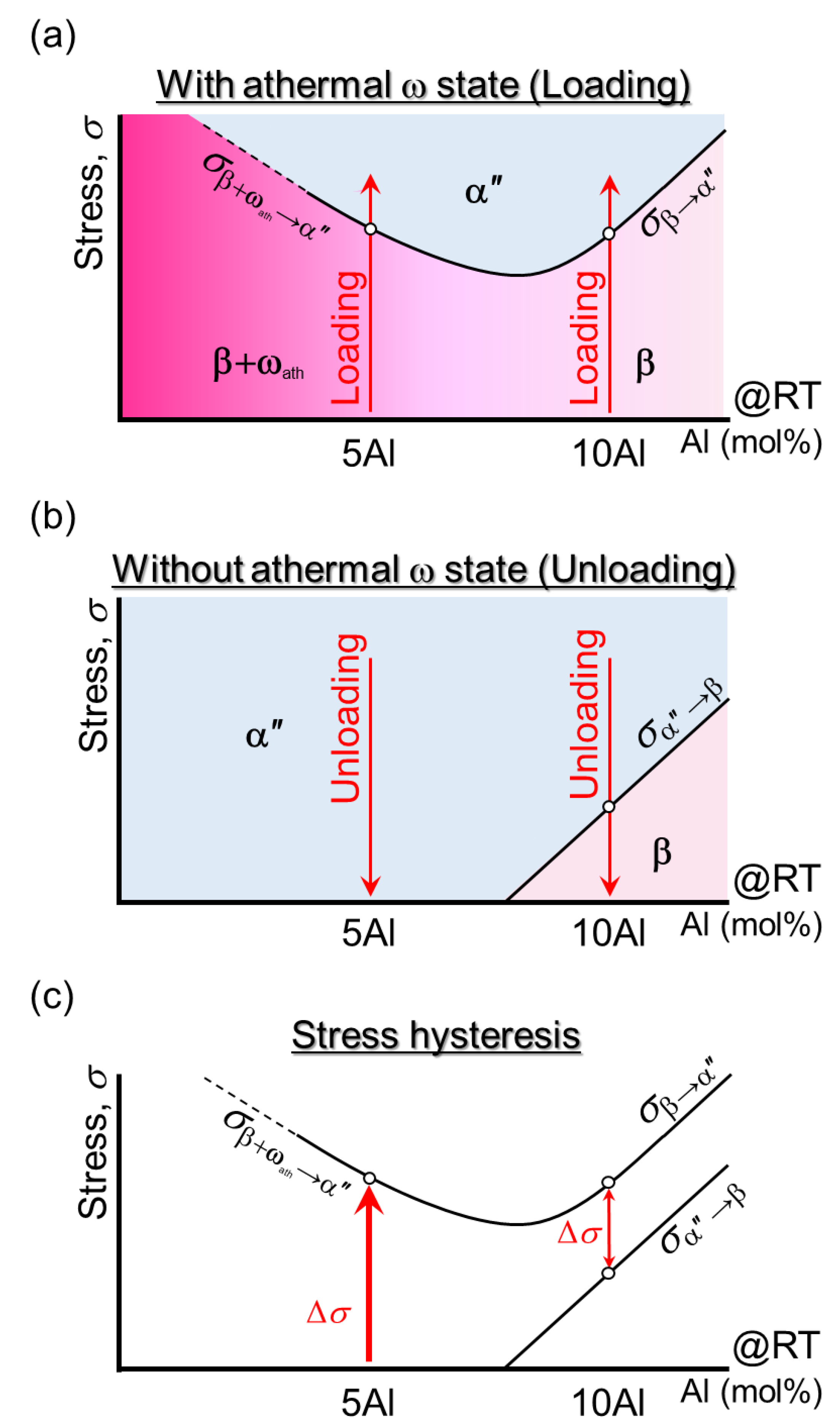Achievement of Room Temperature Superelasticity in Ti-Mo-Al Alloy System via Manipulation of ω Phase Stability
Abstract
1. Introduction
2. Materials and Methods
3. Results and Discussion
4. Conclusions
Supplementary Materials
Author Contributions
Funding
Institutional Review Board Statement
Informed Consent Statement
Data Availability Statement
Acknowledgments
Conflicts of Interest
References
- Biesiekierski, A.; Wang, J.; Abdel-Hady Gepreel, M.; Wen, C. A new look at biomedical ti-based shape memory alloys. Acta Biomater. 2012, 8, 1661–1669. [Google Scholar] [CrossRef] [PubMed]
- Li, Y.; Yang, C.; Zhao, H.; Qu, S.; Li, X.; Li, Y. New developments of Ti-based alloys for biomedical applications. Materials 2014, 7, 1709–1800. [Google Scholar] [CrossRef] [PubMed]
- Boyer, R.; Welsch, G.; Collings, E.W. Materials Properties Handbook: Titanium Alloys; ASM International: Materials Park, OH, USA, 1994. [Google Scholar]
- Davis, R.; Flower, H.M.; West, D.R.F. Martensitic Transformations in Ti-Mo Alloys. J. Mater. Sci. 1979, 14, 712–722. [Google Scholar] [CrossRef]
- Maeshima, T.; Nishida, M. Shape memory properties of biomedical Ti-Mo-Ag and Ti-Mo-Sn alloys. Mater. Trans. 2004, 45, 1096–1100. [Google Scholar] [CrossRef]
- Maeshima, T.; Nishida, M. Shape memory and mechanical properties of biomedical Ti-Sc-Mo alloys. Mater. Trans. 2004, 45, 1101–1105. [Google Scholar] [CrossRef][Green Version]
- Kim, H.Y.; Ohmatsu, Y.; Kim, J.I.; Hosoda, H.; Miyazaki, S. Mechanical properties and shape memory behavior of Ti-Mo-Ga alloys. Mater. Trans. 2004, 45, 1090–1095. [Google Scholar] [CrossRef]
- Maeshima, T.; Ushimaru, S.; Yamauchi, K.; Nishida, M. Effect of heat treatment on shape memory effect and superelasticity in Ti-Mo-Sn alloys. Mater. Sci. Eng. A 2006, 438–440, 844–847. [Google Scholar] [CrossRef]
- Endoh, K.; Tahara, M.; Inamura, T.; Hosoda, H. Effect of Sn and Zr content on superelastic properties of Ti-Mo-Sn-Zr biomedical alloys. Mater. Sci. Eng. A 2017, 704, 72–76. [Google Scholar] [CrossRef]
- Sugano, D.; Ikeda, M. The effect of aluminum content on phase constitution and heat treatment behavior of Ti-Cr-Al alloys for healthcare application. Mater. Sci. Eng. C 2005, 25, 377–381. [Google Scholar] [CrossRef]
- Buenconsejo, P.J.S.; Kim, H.Y.; Miyazaki, S. Novel β-TiTaAl alloys with excellent cold workability and a stable high-temperature shape memory effect. Scr. Mater. 2011, 64, 1114–1117. [Google Scholar] [CrossRef]
- Fukui, Y.; Inamura, T.; Hosoda, H.; Wakashima, K.; Miyazaki, S. Mechanical properties of a Ti-Nb-Al shape memory alloy. Mater. Trans. 2004, 45, 1077–1082. [Google Scholar] [CrossRef]
- Hosoda, H.; Kinoshita, Y.; Fukui, Y.; Inamura, T.; Wakashima, K.; Kim, H.Y.; Miyazaki, S. Effects of short time heat treatment on superelastic properties of a Ti-Nb-Al biomedical shape memory alloy. Mater. Sci. Eng. A 2006, 438–440, 870–874. [Google Scholar] [CrossRef]
- Farooq, M.U.; Khalid, F.A.; Zaigham, H.; Abidi, I.H. Superelastic behaviour of Ti-Nb-Al ternary shape memory alloys for biomedical applications. Mater. Lett. 2014, 121, 58–61. [Google Scholar] [CrossRef]
- Sasano, H.; Suzuki, T. Shape Memory Effect in Ti-Mo-Al Alloys. In Proceedings of the 5th International Conference on Titanium, Munich, Germany, 10–14 September 1984; pp. 1667–1674. [Google Scholar]
- Hosoda, H.; Hosoda, N.; Miyazaki, S. Mechanical properties of Ti-Mo-Al biomedical shape memory alloys. Trans. Mater. Res. Soc. Japan 2001, 26, 243–246. [Google Scholar]
- Ijaz, M.F.; Kim, H.Y.; Hosoda, H.; Miyazaki, S. Effect of Sn addition on stress hysteresis and superelastic properties of a Ti-15Nb-3Mo alloy. Scr. Mater. 2014, 72–73, 29–32. [Google Scholar] [CrossRef]
- Ishiyama, S.; Hanada, S.; Izumi, O. Effect of Zr, Sn and Al additions on deformation mode and beta phase stability of metastable beta Ti alloys. ISIJ Int. 1991, 31, 807–813. [Google Scholar] [CrossRef]
- Ohyama, H.; Nishimura, T. Effects of alloying elements on deformation mode in Ti-V based β titanium alloy system. ISIJ Int. 1995, 35, 927–936. [Google Scholar] [CrossRef]
- Wang, W.; Zhang, X.; Sun, J. Phase stability and tensile behavior of metastable β Ti-V-Fe and Ti-V-Fe-Al alloys. Mater. Charact. 2018, 142, 398–405. [Google Scholar] [CrossRef]
- Williams, J.C.; Hickman, B.S.; Leslie, D.H. The effect of ternary additions on the decompositon of metastable beta-phase titanium alloys. Metall. Trans. 1971, 2, 477–484. [Google Scholar] [CrossRef]
- Pang, E.L.; Pickering, E.J.; Baik, S.I.; Seidman, D.N.; Jones, N.G. The effect of zirconium on the omega phase in Ti-24Nb-[0–8]Zr (at.%) alloys. Acta Mater. 2018, 153, 62–70. [Google Scholar] [CrossRef]
- Matsugi, K.; Kishimoto, H.; Yamakawa, D.; Xu, Z.-F.; Choi, Y.-B. Compositional optimization of β type titanium alloys with shape memory ability and their characteristics. Mater. Trans. 2015, 56, 1747–1755. [Google Scholar] [CrossRef]
- Wang, C.H.; Liu, M.; Hu, P.F.; Peng, J.C.; Wang, J.A.; Ren, Z.M.; Cao, G.H. The effects of α″ and ω phases on the superelasticity and shape memory effect of binary Ti-Mo alloys. J. Alloys Compd. 2017, 720, 488–496. [Google Scholar] [CrossRef]
- Hanada, S.; Izumi, O. Transmission electron microscopic observations of mechanical twinning in metastable beta titanium alloys. Metall. Trans. A 1986, 17, 1409–1420. [Google Scholar] [CrossRef]
- Takemoto, Y.; Shimizu, I.; Sakakibara, A.; Senuma, T. Change of elastic behavior in binary β-type Ti alloys with deformation. J. Japan Inst. Met. 2006, 70, 110–113. [Google Scholar] [CrossRef][Green Version]
- Sun, F.; Zhang, J.Y.; Marteleur, M.; Gloriant, T.; Vermaut, P.; Laillé, D.; Castany, P.; Curfs, C.; Jacques, P.J.; Prima, F. Investigation of early stage deformation mechanisms in a metastable β titanium alloy showing combined twinning-induced plasticity and transformation-induced plasticity effects. Acta Mater. 2013, 61, 6406–6417. [Google Scholar] [CrossRef]
- Zhang, J.Y.; Li, J.S.; Chen, Z.; Meng, Q.K.; Sun, F.; Shen, B.L. Microstructural evolution of a ductile metastable β titanium alloy with combined TRIP/TWIP effects. J. Alloys Compd. 2017, 699, 775–782. [Google Scholar] [CrossRef]
- Mantri, S.A.; Sun, F.; Choudhuri, D.; Alam, T.; Gwalani, B.; Prima, F.; Banerjee, R. Deformation induced hierarchical twinning coupled with omega transformation in a metastable β-Ti alloy. Sci. Rep. 2019, 9, 1334. [Google Scholar] [CrossRef]
- Im, Y.D.; Lee, Y.K. Effects of Mo concentration on recrystallization texture, deformation mechanism and mechanical properties of Ti-Mo binary alloys. J. Alloys Compd. 2020, 821, 153508. [Google Scholar] [CrossRef]
- Oka, M.; Taniguchi, Y. Stress-induced products in meta-stable beta Ti-Mo and Ti-V alloys. J. Japan Inst. Met. 1978, 42, 814–820. [Google Scholar] [CrossRef][Green Version]
- Kim, H.Y.; Ikehara, Y.; Kim, J.I.; Hosoda, H.; Miyazaki, S. Martensitic transformation, shape memory effect and superelasticity of Ti-Nb binary alloys. Acta Mater. 2006, 54, 2419–2429. [Google Scholar] [CrossRef]
- Buenconsejo, P.J.S.; Kim, H.Y.; Miyazaki, S. Effect of ternary alloying elements on the shape memory behavior of Ti-Ta alloys. Acta Mater. 2009, 57, 2509–2515. [Google Scholar] [CrossRef]
- Kim, H.Y.; Nakai, K.; Fu, J.; Miyazaki, S. Effect of Al addition on superelastic properties of Ti-Zr-Nb-based alloys. Funct. Mater. Lett. 2017, 10, 1740002. [Google Scholar] [CrossRef]
- Kim, H.Y.; Hashimoto, S.; Kim, J.I.; Hosoda, H.; Miyazaki, S. Mechanical properties and shape memory behavior of Ti-Nb alloys. Mater. Trans. 2004, 45, 2443–2448. [Google Scholar] [CrossRef]
- Kim, J.I.; Kim, H.Y.; Inamura, T.; Hosoda, H.; Miyazaki, S. Shape memory characteristics of Ti-22Nb-(2–8)Zr(at.%) biomedical alloys. Mater. Sci. Eng. A 2005, 403, 334–339. [Google Scholar] [CrossRef]
- Kim, H.Y.; Hashimoto, S.; Kim, J.I.; Inamura, T.; Hosoda, H.; Miyazaki, S. Effect of Ta addition on shape memory behavior of Ti-22Nb alloy. Mater. Sci. Eng. A 2006, 417, 120–128. [Google Scholar] [CrossRef]
- Gao, J.J.; Thibon, I.; Castany, P.; Gloriant, T. Effect of grain size on the recovery strain in a new Ti-20Zr-12Nb-2Sn superelastic alloy. Mater. Sci. Eng. A 2020, 793, 139878. [Google Scholar] [CrossRef]





| Alloy | (a) Quenched-In State | (b) Phase Stability | (c) Loading | (d) After Unloading |
|---|---|---|---|---|
| 0Al | β + ωath | α″ | β + ωath → βtwin (+ α″) | βtwin (+ α″) |
| 5Al | β + ωath | α″ | β + ωath → α″ | α″ |
| 10Al | β (+ ωath) | β | β → α″ | β |
Publisher’s Note: MDPI stays neutral with regard to jurisdictional claims in published maps and institutional affiliations. |
© 2022 by the authors. Licensee MDPI, Basel, Switzerland. This article is an open access article distributed under the terms and conditions of the Creative Commons Attribution (CC BY) license (https://creativecommons.org/licenses/by/4.0/).
Share and Cite
Nohira, N.; Chiu, W.-T.; Umise, A.; Tahara, M.; Hosoda, H. Achievement of Room Temperature Superelasticity in Ti-Mo-Al Alloy System via Manipulation of ω Phase Stability. Materials 2022, 15, 861. https://doi.org/10.3390/ma15030861
Nohira N, Chiu W-T, Umise A, Tahara M, Hosoda H. Achievement of Room Temperature Superelasticity in Ti-Mo-Al Alloy System via Manipulation of ω Phase Stability. Materials. 2022; 15(3):861. https://doi.org/10.3390/ma15030861
Chicago/Turabian StyleNohira, Naoki, Wan-Ting Chiu, Akira Umise, Masaki Tahara, and Hideki Hosoda. 2022. "Achievement of Room Temperature Superelasticity in Ti-Mo-Al Alloy System via Manipulation of ω Phase Stability" Materials 15, no. 3: 861. https://doi.org/10.3390/ma15030861
APA StyleNohira, N., Chiu, W.-T., Umise, A., Tahara, M., & Hosoda, H. (2022). Achievement of Room Temperature Superelasticity in Ti-Mo-Al Alloy System via Manipulation of ω Phase Stability. Materials, 15(3), 861. https://doi.org/10.3390/ma15030861







